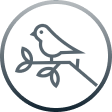Bird detection: how a neural network helps avoid aircraft collision with birds during takeoff and landing
Bird recognition (agriculture)
Another possibility of using
a neural network
a neural network

Problem
Airplanes and helicopters collide with birds 5,400 times a year (according to the International Civil Aviation Organization).
For 25 years, 160 aircraft have been damaged and 200 people have died due to collisions.
Airplanes and helicopters collide with birds 5,400 times a year (according to the International Civil Aviation Organization).
For 25 years, 160 aircraft have been damaged and 200 people have died due to collisions.
Panoramic camera notices birds and transmits data to the server via Wi-Fi. On the server, our algorithm recognizes objects that look like birds. If they are detected, the PTZ camera automatically aims at objects by coordinates and enlarges the picture. If they are indeed birds, the algorithm determines their size, number, direction of movement and the degree of threat to aircraft. In case of danger, the signal is sent to the operator.
Solution
Airports have employees who track birds with binoculars or with cameras installed at the point where the aircraft leaves the runway. These methods are time-consuming and inefficient, so we have created a system that automatically detects and warns of birds in front of the aircraft.
Airports have employees who track birds with binoculars or with cameras installed at the point where the aircraft leaves the runway. These methods are time-consuming and inefficient, so we have created a system that automatically detects and warns of birds in front of the aircraft.

What the system can do
Technologies
We used the programming language - Python and C++. Machine learning libraries - Tensor Flow, Keras, Numpy, pandas, as well as web interface building tools - are HTML and C.
Project nuances
For the system to work, it is important to consider three points:
need to install cameras with the ability to view the runway;
power supply for cameras at the mounting point;
Internet at a speed of 1 Gbps at the server installation point.
The second nuance: so far the system works only in clear weather. At night or in heavy fog, a regular camera does not notice objects, but this is solved by using cameras with a thermal imager.
Development
At the next stages, we plan to add the ability to scare away birds using ultrasound.
- Detect birds in the danger zone in the air and on the ground
- Determine parameters: distance to birds, direction of movement, number, size, actions of birds on the ground and in the air
- Automatically give a signal if the birds are in the danger zone
- Display the image on the operator's monitor
Technologies
We used the programming language - Python and C++. Machine learning libraries - Tensor Flow, Keras, Numpy, pandas, as well as web interface building tools - are HTML and C.
Project nuances
For the system to work, it is important to consider three points:
need to install cameras with the ability to view the runway;
power supply for cameras at the mounting point;
Internet at a speed of 1 Gbps at the server installation point.
The second nuance: so far the system works only in clear weather. At night or in heavy fog, a regular camera does not notice objects, but this is solved by using cameras with a thermal imager.
Development
At the next stages, we plan to add the ability to scare away birds using ultrasound.
Timing
The project consisted of seven stages. At the first stage, we taught the system to identify birds, at the last stage, we launched and finalized the errors.
The project consisted of seven stages. At the first stage, we taught the system to identify birds, at the last stage, we launched and finalized the errors.
Team
The pilot project team consisted of three people: a machine learning and neural network programmer, DevOps, and a project manager.
The pilot project team consisted of three people: a machine learning and neural network programmer, DevOps, and a project manager.


